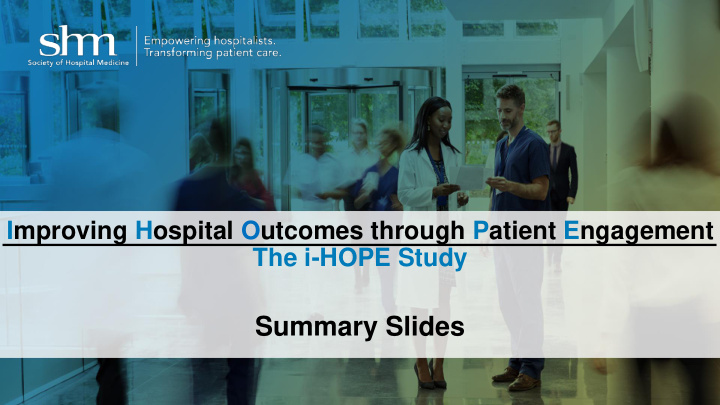



Improving Hospital Outcomes through Patient Engagement The i-HOPE Study Summary Slides
i-HOPE Improving Hospital Outcomes Through Patient Engagement The i-HOPE Project • Hospitalist researchers + patient partners joined forces to develop a priority research agenda • Resource for patients, families, stakeholders, researchers, and funders • Form connections between patients, stakeholders, and researchers
i-HOPE Improving Hospital Outcomes Through Patient Engagement Project aims 1. Engage patients, families and other stakeholders to generate a priority list of research topics and unanswered questions important to the care of hospitalized patients. 2. Create a network of patient, family, and stakeholder collaborators to advise, review, and participate in future research undertaken in response to these priorities
Stakeholder Partner Organizations
i-HOPE Improving Hospital Outcomes Through Patient Engagement Approach to priority setting • James Lind Alliance: Standard approach to priority- setting partnerships • Multi-step approach: – Identification of stakeholders – Collect feedback re: unanswered questions – Refine / categorize questions – Prioritize questions x 2 – Create dissemination plan
i-HOPE Improving Hospital Outcomes Through Patient Engagement Who Submitted Questions? 499 respondents submitted 789 questions
i-HOPE Prioritized Research Questions In original wording How can we ensure shared decision-making and that patients and families are included in treatment decision-making and goals of 1 care discussion? How can the hospital discharge hand off to other care facilities (e.g. SNFs), primary care providers and specialists be made 2 smoother? How can education on medications, medical conditions, hospital care and discharge be better coordinated by the care team, and 3 not so confusing and overwhelming to patients? How can patients, family members, other caregivers and heath care teams work together to create effective discharge experiences 4 that allow patients to feel empowered to manage their health once they get home? How do we ensure that information provided by the care team during hospitalization and at discharge was clearly understood and 5 clearly communicated by patients and caregivers? How can we use telemedicine technology to improve transitions of care and reduce re-hospitalization? 6 Who do I call if I have any questions after I have been discharged? 7 Did your health-care providers explain to you what your problem or diagnosis is, what steps were done to further explore that 8 condition, what treatment was undertaken, and what will still need to be done after discharge? What are patient expectations related to the treatment of pain/chronic pain? 9 Which interventions improve medication reconciliation at key time points of the care trajectory (hospital/home, 10 admission/discharge) and what are each intervention’s outcomes? Can hospital staff be more transparent about hospital practices (e.g. parking, cafeteria, rules about protocol for entering patient 11 rooms, rounds, and sleep interruptions)?
i-HOPE Prioritized Questions Refined for Research 1 What interventions ensure that patients share in decision making regarding their goals and plans of care? 2 What are the most effective discharge handoff practices between hospitals and other providers? 3 How can the care team best coordinate education on medications, medical conditions, hospital care and discharge for hospitalized patients to minimize confusion? 4 For inpatients, what comprises a collaborative discharge process that fosters understanding, empowerment, and effective management of their health at home? 5 What are effective strategies to identifying and overcoming barriers to comprehension of information delivered to patients during hospitalization and at discharge? 6 Can telemedicine technology be used to reduce readmissions or improve transitions of care in hospitalized patients? 7 Who should the patient call after discharge, if they have questions, concerns, or need to be connected to appropriate resources? 8 What are the most effective ways for patients and providers to partner in understanding information about diagnosis, steps taken to explore it, treatments undertaken, and what needs to happen after discharge? 9 What are patients’ expectations related to the treatment of pain? 10 What are the best interventions to achieve medication optimization throughout a patient’s care trajectory? 11 Would providing more clear and accessible information regarding hospital practices (e.g. parking, cafeteria, protocols for entering rooms, etc.) result in improved patient experiences compared to current practices?
i-HOPE Improving Hospital Outcomes Through Patient Engagement Dissemination Plans • Patients, Patient & Family Advisory Councils • Stakeholder partners • Professional Societies • Social media • Presentations and papers • Get involved! We hope you will use these questions for your own improvement efforts!
i-HOPE Improving Hospital Outcomes Through Patient Engagement Thank You!! • Visit the i-HOPE website to learn more, and get involved! • https://www.hospitalmedicine.org/clinical-topics/i-hope-study/
Recommend
More recommend